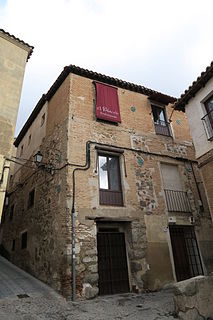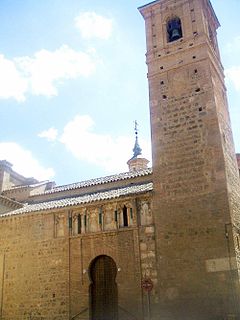Related Research Articles

Toledo is a city and municipality of Spain, capital of the province of Toledo and the de jure seat of the government and parliament of the autonomous community of Castilla–La Mancha. Toledo was declared a World Heritage Site by UNESCO in 1986 for its extensive monumental and cultural heritage.

Francisco Álvarez Martínez is the former archbishop of the Spanish see of Toledo and a Cardinal in the Roman Catholic Church.

The Roman Catholic Archdiocese of Madrid is one of Spain's fourteen Metropolitan Archbishoprics. Incumbent Archbishop of Madrid since 28 August 2014 is Carlos Osoro Sierra, until then Archbishop of Valencia.

The Mosque of Cristo de la Luz is a former mosque in Toledo, Spain. It is the one of the ten that existed in the city during the Moorish period. The edifice was then known as Mezquita Bab-al-Mardum, deriving its name from the city gate Bab al-Mardum. It is located near the Puerta del Sol, in an area of the city once called Medina where wealthy Muslims used to live.

The Roman Catholic Diocese of Gibraltar is a diocese of the Latin Church of the Roman Catholic Church in the British overseas territory of Gibraltar. The Latin name for the diocese is Dioecesis Gibraltariensis. About twenty priests and nine sisters serve in the diocese. Carmelo Zammit was installed as bishop on 24 September 2016. At just over 6 square kilometers, it is among the smallest of all Catholic dioceses in the world.
The cardinal electors in the 1963 papal conclave numbered 82, of whom 80 participated. This papal conclave met from 19 to 21 June 1963. This list is arranged by region and within each alphabetically.

The Iglesia de El Salvador is a church in Toledo, Spain completed in 1159.

Manuel Monteiro de Castro is a Portuguese prelate of the Catholic Church who worked in the diplomatic service of the Holy See from 1967 to 2009, with the rank of archbishop and the title of nuncio from 1985. His assignments as nuncio included the Caribbean, South Africa, Central America, and Spain. He ended his career in senior positions in the Roman Curia from 2009 to 2013. He was made a cardinal in 2012.

Braian Ezequiel Toledo was an Argentine javelin thrower who improved the World Youth Best in boys' javelin throw by more than six metres.

The Museum of Santa Cruz is an art, archaeology and ethnographic museum located in the historic centre of the city of Toledo, Spain. It exhibits collections pertaining to the province of Toledo, including works painted by El Greco in the city of Toledo.

The Cave of Hercules is a subterranean vaulted space dating back to Roman times located in the alley of San Ginés in the city of Toledo, Spain. The cave is under a building located where the Church of San Ginés, Toledo stood until 1841.

The Convento de San Clemente is a Renaissance convent located in the city of Toledo, in Castile-La Mancha, Spain. It was founded in the 13th century during the reign of Alfonso X of Castile the Wise. Inside the building there are a Roman cistern, Mudéjar architecture, remains of the Palacio de los Cervatos and many decorative elements. It was rebuilt by Alonso de Covarrubias, and a cloister by José Ortega.
The Roman baths of Toledo or Roman thermae of Amador de los Ríos are ruins of Roman thermae located in the city of Toledo in Castile-La Mancha, Spain. The baths can be seen as part of the system of supplying clean water to the city. From the scale of the surviving infrastructure, they are assumed to have been a public facility.
The Baños del Ángel or Baños de Zeid are an Islamic baths located in the city of Toledo, in Castile-La Mancha, Spain. These are undoubtedly one of the best preserved among the eight that still maintain recognizable structures within the Historic Quarter of Toledo.

The Templar House in Toledo, in Castile-La Mancha, Spain, was built and decorated between the years 1085 and 1114, belonging to this period the general structure, typically Al-Andalusian, supported by the vaults of the basement and organized around the courtyard. The strict contemporaneousness existing between this monument of Toledo, the Aljafería palace of Zaragoza (1046–1082), and the roofing of the church of San Millán of Segovia is shown by the fact that the large majority of the construction elements for the roofs and ornamental designs are practically the same on all three buildings.

The iglesia de San Andrés is a church located in the city of Toledo, in Castile-La Mancha, Spain. The iglesia de San Andrés, as is common in this city, is a mix of different styles. On the one hand, there are present Mudéjar and Gothic architecture, and also, the Baroque, following a remodeling of the 17th century. After the last restoration traceries appeared in the facade that evoke the eclecticism of the crossing. A Visigoth relief and two Visigothic pilasters was also discovered.

The Convento de Santa Clara la Real is a convent of the Poor Clares located in the city of Toledo, Castile-La Mancha, Spain. The present convent was founded in the middle of the 14th century by Toledan noblewoman María Meléndez, and is located near other monasteries of note, such as the monastery of Santo Domingo el Real and the Convent of Capuchins of Toledo.

The Hospital del Nuncio Nuevo is a Neoclassical hospital located in city of Toledo, in Castile-La Mancha, Spain. It was commissioned by Cardinal Lorenzana at the end of the 18th century. Built to house people with mental illness, it represents an advanced hospital architecture for its time.
Underneath the historic town of Toledo, Spain there is an underground city made up of wells, caves, Roman, Arabic, and Judaic baths, as well as centuries-old cemeteries. Previously little known, the underground structures have become a focus of tourist interest.

The Palacio del Marqués de Malpica is a building in the city of Toledo, Castile-La Mancha, Spain. It's located at the Plaza de Santa Clara and next to the monastery of the same name. It is of Renaissance style and belonged to the Marquis of Malpica y Valdepusa.
References
- ↑ Rutas Patrimonio Desconocido (PDF). Consorciotoledo.com. p. 27. Retrieved 2017-03-01.
- ↑ MURALLAS, PUERTAS Y PUENTES DE TOLEDO (PDF). Turismoestoledo.com. Retrieved 2017-03-01.

